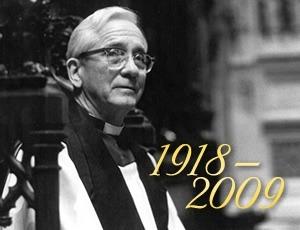Trinity's 15th Rector, Dr. Robert Parks, Dies
Visit the comments section to share your memories of Dr. Parks.
The Parks family has requested that in lieu of flowers, donations in Dr. Parks' honor may be given to Jacksonville Episcopal High School, which is currently developing the Robert R. and Nancy B. Parks Academic Building.</i>
A priest who built residential towers for the elderly and schools for the young in two American cities, the Rev. Dr. Robert Ray Parks died Sunday just before the 10 am service at All Saints’ Church in New York City. He was 91 years old.
His family and friends, former parishioners, and a large number of ordained men and women whom he encouraged to enter the ministry, are remembering him as a humble man who both helmed one of the world’s wealthiest parishes in Trinity Wall Street, and as a plain-spoken evangelical priest with a deep concern for the problems facing urban American communities.
Prior to his tenure at Trinity Church, where he was 15th rector of the parish, Dr. Parks was Dean of St. John's Cathedral in Jacksonville, Florida. He revived the cathedral as a house of worship, co-founded the Episcopal High School of Jacksonville, and established the Cathedral Health and Rehabilitation Center, at the time the only rehabilitation hospital in Northern Florida.
In New York, among his many accomplishments was the construction of St. Margaret’s House, a 22-story, 250-unit residence for the elderly and disabled on Pearl and Fulton Streets in Lower Manhattan.
Dr. Parks was called as Trinity’s rector with a mandate to implement changes in the corporate structure of the parish. He started many of the programs and ministries the parish is known for today.
At the outset of his tenure in 1972, Trinity was still known as the “mother church” of Episcopal New York – when it had seen a need over the centuries, the church had built a chapel. Dr. Parks would put into effect the results of a parish analysis that called for self-governance by the congregations of Trinity Church and its chapels, then numbering five.
In 1976, Trinity’s chapels of St. Luke’s, St. Augustine’s, and Intercession were set free by Trinity. Trinity Church, St. Paul’s Chapel, and St. Cornelius on Governors Island remain the only houses of worship operated by Trinity Wall Street.
With the chapels on their own, Dr. Parks turned his eye toward program and ministry. His interest in a ministry to the elderly, which had been expressed in Jacksonville, was put into action at Trinity with the construction in 1982 of St. Margaret’s House.
Built with a U.S. Department of Housing and Urban Development loan, St. Margaret’s represented a significant step forward in the development of quality subsidized housing for America’s aging. It is focused around the concept of “congregate” communal residency and today is widely seen as a model for other organizations.
Dr. Parks was also instrumental in the further development of Trinity’s uptown cemetery at 155th Street and Broadway, the resting place of John J. Audubon and Clement Clark Moore, among others. Under Dr. Parks’, the cemetery added a mausoleum, and It continues as the only active burial site on Manhattan Island today.
In 1980, Dr. Parks opened a new parish hall and enhanced the parish’s communications capacity with the installation of a television studio. Furthering his interest in the church providing educational opportunities for the community at large, the Trinity Preschool and Nursery was opened and continues to serve children and families in Lower Manhattan. Dr. Parks’ leadership also established the Trinity Grants Program, a multi-million dollar philanthropy that works in New York City and worldwide to improve the quality of people’s lives.
To these ministry mainstays he added an architectural grace note -- the pedestrian bridge that connects Trinity Church to its administrative offices across the street on Trinity Place, an elegant and useful reminder of what many call Dr. Parks’ unique gift to bring vision into reality.
Dr. Parks was born in Ty Ty, Georgia, in 1918 and grew up in a devout Methodist family that made a practice of tithing – a long-running theme of his ministry – and prayed before every meal. The decision to enter the ordained ministry came during a period of convalescence. Dr. Parks, a Navy pilot during World War II, crash-landed his plane near Lake City, Florida, and suffered serious spine injuries. As The New York Times reported after his Trinity installation, doctors gave up hope of full recovery, and Parks turned to prayer and was healed. He told the reporter, “It was about as direct a personal religious experience as a person can have.”
Dr. Parks would turn that personal experience into a ministry that was very public and excluded no one. In a later, 2006 interview, he spoke of a priest’s essential ability to be able to talk to anyone across the social spectrum, from those who command little of society’s respect, to figures of power and wealth.
When Dr. Parks received an honorary Doctor of Divinity degree from the University of the South in 1970, the citation commended him for “communicating his vision of total ministry to his community that related the Christian faith to every phase of public and private life.”
In retirement, Dr. Parks and his wife, Nancy, attended All Saints’ Episcopal Church for more than two decades. “He was very supportive,” said the Rev. Steven Yagerman, All Saints’ Rector. “At annual meetings he might stand up to say a few words. With the depth of his experience and conviction, when he spoke, people listened.”
On the Sunday of his death, Dr. Parks and his wife had walked to church, despite the rain, where he died peacefully as he began to pray.






